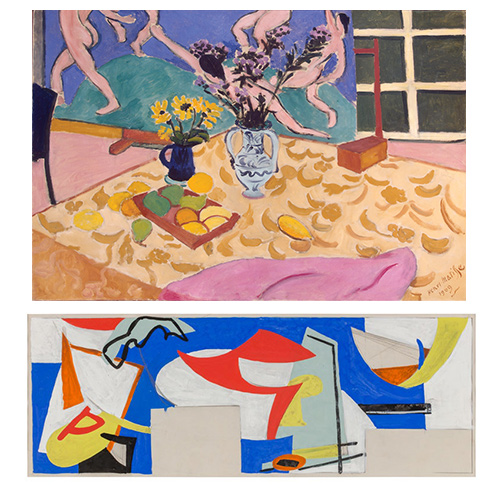
Top: Still Life with The Dance, 1909, by Henri Matisse (Hermitage Museum, St. Petersburg) Bottom: Lee Krasner, Untitled Mural Study, 1940
The radical innovations made by European and American painters and sculptors between 1900 and 1960 forever altered the way we think about visual art. Before World War I, fauvist and expressionist painters challenged the traditional Western concept of beauty, while Picasso and Malevich took on thousands of years of art history by exploring the controversial realm of abstraction.
Between the wars, artists as different as Salvador Dalí and Frida Kahlo made images based on their own dreams and hallucinations. Later, American art finally achieved international recognition through the enormous, dramatic canvases of Jackson Pollock, paving the way for several decades of cultural prominence that began in the 1960s.
In this richly illustrated course, art historian Nancy G. Heller, professor emerita of art history at the University of the Arts in Philadelphia, discusses major works by the period’s seminal painters and sculptors, emphasizing their broader socio-political and aesthetic contexts.
Friday, June 9 (6:30 to 8 p.m. ET)
Revolutionary developments in France begin with fauvism—the glorious color and joyous shapes of Henri Matisse plus other, related painters including André Derain and Marguerite Thompson Zorach.
Saturday, June 10 (10 a.m. to 4 p.m. ET)
10 to 11:15 a.m. Empathy and Shock
At the same time that fauvism was revolutionizing French art, radical German expressionists like Ernst Ludwig Kirchner, Kaethe Kollwitz, and Ernst Barlach created powerfully emotional paintings, prints, and sculptures.
11:30 a.m. to 12:45 p.m. Beyond Realism and Narrative
The invention and dissemination of cubism by Pablo Picasso and Georges Braque, and the totally nonrepresentational works of Kasimir Malevich, Piet Mondrian, and Hilma Af Klint.
12:45 to 1:15 p.m. Break
1:15 to 2:30 p.m. Exploring the Subconscious
Dada, a product of World War I nihilism, as seen in the art of Marcel Duchamp, and its descendant, Surrealism, exemplified by the wild imaginings of Salvador Dalí and the extraordinary autobiographical paintings of Frida Kahlo.
2:45 to 4 p.m. The Triumph of American Painting
After the Second World War the United States becomes the international center for cutting-edge art, with the huge and dramatic canvases of Jackson Pollock, Willem de Kooning, Mark Rothko, and Lee Krasner.
2 sessions
World Art History Certificate core course: Earn 1 credit*
General Information
*Enrolled participants in the World Art History Certificate Program receive 1 core course credit. Not yet enrolled? Learn about the program, its benefits, and how to register here.